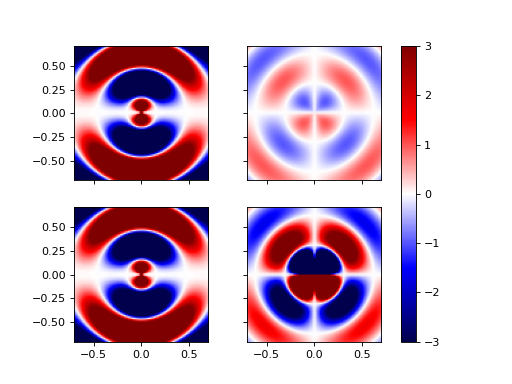differential_geometry.dense_ops.dense_gradient_contravariant_full#
- differential_geometry.dense_ops.dense_gradient_contravariant_full(tensor_field: ndarray, inverse_metric_field: ndarray, rank: int, ndim: int, *varargs, field_axes: Sequence[int] | None = None, output_indices: Sequence[int] | None = None, out: ndarray | None = None, edge_order: Literal[1, 2] = 2, **kwargs) ndarray[source]#
Compute the contravariant gradient \(\nabla^\mu T^{\dots}\) using the inverse metric tensor.
This function computes the covariant (partial) derivatives of a tensor field and then raises the newly introduced index using the inverse metric:
\[(\nabla^\mu T^{\dots}) = g^{\mu\nu} \partial_\nu T^{\dots}\]The result has one additional tensor index appended (contravariant index from differentiation).
Warning
This is a low-level routine and does not validate input shapes or metric consistency. It assumes all inputs are correctly broadcast and aligned.
- Parameters:
tensor_field (
numpy.ndarray) –Tensor field of shape
(F_1, ..., F_m, N, ...), where the last rank axes are the tensor index dimensions. The partial derivatives are computed over the first m axes.Hint
Because this function is a low-level callable, it does not enforce the density of the elements in the trailing dimensions of the field. This can be used in some cases where the field is not technically a tensor field.
inverse_metric_field (
numpy.ndarray) –Inverse metric tensor with shape
(..., ndim, ndim), where the leading dimensions (denoted here asF1, ..., F_n) must be broadcast-compatible with the grid (spatial) portion of tensor_field.Specifically, if tensor_field has shape
(S1, ..., S_m, I1, ..., I_rank), then inverse_metric_field must be broadcast-compatible with(S1, ..., S_m). The last two dimensions must be exactly(ndim, ndim), representing the inverse metric at each grid point.rank (
int) – Number of trailing axes that represent tensor indices (i.e., tensor rank). The rank determines the number of identified coordinate axes and therefore determines the shape of the returned array.ndim (
int) – The number of total dimensions in the relevant coordinate system. This determines the maximum allowed value formand the number of elements in the trailing dimension of the output.*varargs –
Grid spacing for each spatial axis. Follows the same format as
numpy.gradient(), and can be:A single scalar (applied to all spatial axes),
A list of scalars (one per axis),
A list of coordinate arrays (one per axis),
A mix of scalars and arrays (broadcast-compatible).
If field_axes is provided, varargs must match its length. If axes is not provided, then varargs should be
tensor_field.ndim - rankin length (or be a scalar).field_axes (
listofint, optional) – The spatial axes over which to compute the component-wise partial derivatives. If field_axes is not specified, then alltensor_field.ndim - rankaxes are computed.output_indices (
listofint, optional) –Explicit mapping from each axis listed in field_axes to the indices in the output’s final dimension of size
ndim. This parameter allows precise control over the placement of computed gradients within the output array.If provided, output_indices must have the same length as field_axes. Each computed gradient along the spatial axis
field_axes[i]will be stored at indexoutput_indices[i]in the last dimension of the output.If omitted, the default behavior is
output_indices = field_axes, i.e., gradients are placed in the output slot corresponding to their source axis.Note
All positions in the final axis of the output array not listed in
output_indicesare left unmodified (typically zero-filled unlessoutwas pre-populated).edge_order (
{1, 2}, optional) – Gradient is calculated using N-th order accurate differences at the boundaries. Default: 1.out (
numpy.ndarray, optional) – Buffer in which to store the output to preserve memory. If provided, out must have shapetensor_field.shape + (ndim,). If out is not specified, then it is allocated during the function call.**kwargs – Additional keyword arguments passed to
numpy.einsum()for the metric contraction.
- Returns:
The contravariant gradient of the input tensor field, with shape
B + (ndim,), whereBis the broadcasted shape of the spatial portion of tensor_field and inverse_metric_field.This result represents the gradient with the differentiation index raised by the inverse metric, and the final axis of size
ndimcorresponds to the contravariant coordinate direction of the derivative at each point.- Return type:
See also
numpy.gradientThe computational backend for this operation.
dense_gradient_covariantContravariant gradient for full metric.
dense_gradient_contravariant_diagContravariant gradient for diagonal metric.
dense_gradientWrapper for user-facing gradient computations.
Notes
In effect, this function calls
dense_gradient_covariant()to compute the covariant gradient and then contracts the result with the metric.Examples
>>> import numpy as np >>> from pymetric.differential_geometry.dense_ops import ( ... dense_gradient_contravariant_full, ... ) >>> >>> x = np.linspace(0, 4, 5) # [0, 1, 2, 3, 4] >>> f = x**2 # [0, 1, 4, 9, 16] >>> >>> inv_metric_full = np.ones((f.size, 1, 1)) # shape broadcast‑compatible with grad_cov >>> grad_contra_full = dense_gradient_contravariant_full( ... f, inv_metric_full,0 , 1, 1.0) >>> grad_contra_full array([[0.], [2.], [4.], [6.], [8.]])
As a more advanced example, let’s look at the co. versus contra. components of a gradient case:
>>> from scipy.interpolate import RegularGridInterpolator >>> from pymetric.differential_geometry.dense_ops import (dense_gradient_contravariant_full, ... dense_gradient_covariant) >>> import matplotlib.pyplot as plt >>> >>> # Create the coordinates, the field, and the >>> # interpolators. >>> r = np.linspace(1e-4,1,1000) >>> theta = np.linspace(0,np.pi,30) >>> R,THETA = np.meshgrid(r,theta,indexing='ij') >>> Z = np.sin(10*R) * np.cos(THETA)**2 >>> >>> # Build a 1D interpolator for Z. >>> interpZ = RegularGridInterpolator((r,theta),Z,bounds_error=False) >>> >>> # Compute the gradients of Z >>> gradZ = dense_gradient_covariant(Z,0,2,r,theta) >>> >>> # Create the metric >>> metric = np.zeros(R.shape + (2,2)) >>> metric[:,:,0,0] = 1 >>> metric[:,:,1,1] = 1/R**2 >>> >>> # Compute the contravariant gradient. >>> gradZcontra = dense_gradient_contravariant_full(Z,metric,0,2,r,theta) >>> >>> # Build interpolators for the 2 gradient components. >>> interpZr = RegularGridInterpolator((r,theta),gradZ[...,0],bounds_error=False) >>> interpZtheta = RegularGridInterpolator((r,theta),gradZ[...,1],bounds_error=False) >>> interpCZr = RegularGridInterpolator((r,theta),gradZcontra[...,0],bounds_error=False) >>> interpCZtheta = RegularGridInterpolator((r,theta),gradZcontra[...,1],bounds_error=False) >>> >>> # Construct an X/Y grid. >>> bound = 1/np.sqrt(2) >>> x,y = np.linspace(-bound,bound,100),np.linspace(-bound,bound,100) >>> X,Y = np.meshgrid(x,y,indexing='ij') >>> RG = np.sqrt(X**2+Y**2) >>> THETAG = np.arccos(Y/RG) >>> grid_points = np.stack([RG.ravel(),THETAG.ravel()],axis=1) >>> Zgrid = interpZ(grid_points).reshape(RG.shape) >>> Zrgrid = interpZr(grid_points).reshape(RG.shape) >>> Zthetagrid = interpZtheta(grid_points).reshape(RG.shape) >>> ZCrgrid = interpCZr(grid_points).reshape(RG.shape) >>> ZCthetagrid = interpCZtheta(grid_points).reshape(RG.shape)
>>> # Setup the figure. >>> fig,axes = plt.subplots(2,2, sharex=True, sharey=True) >>> _ = axes[0,0].imshow(Zrgrid.T ,extent=[-bound,bound,-bound,bound], vmin=-3,vmax=3,cmap='seismic',origin='lower') >>> _ = axes[0,1].imshow(Zthetagrid.T,extent=[-bound,bound,-bound,bound], vmin=-3,vmax=3,cmap='seismic',origin='lower') >>> _ = axes[1,0].imshow(ZCrgrid.T ,extent=[-bound,bound,-bound,bound],vmin=-3,vmax=3,cmap='seismic',origin='lower') >>> P = axes[1,1].imshow(ZCthetagrid.T,extent=[-bound,bound,-bound,bound],vmin=-3,vmax=3,cmap='seismic',origin='lower') >>> _ = plt.colorbar(P,ax=axes) >>> plt.show()
(
Source code,png,hires.png,pdf)